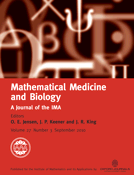-
Views
-
Cite
Cite
Kara L. Maki, Richard J. Braun, William D. Henshaw, P. Ewen King-Smith, Tear film dynamics on an eye-shaped domain I: pressure boundary conditions, Mathematical Medicine and Biology: A Journal of the IMA, Volume 27, Issue 3, September 2010, Pages 227–254, https://doi.org/10.1093/imammb/dqp023
Close - Share Icon Share
Abstract
We study the relaxation of a model for the human tear film after a blink on a stationary eye-shaped domain corresponding to a fully open eye using lubrication theory and explore the effects of viscosity, surface tension, gravity and boundary conditions that specify the pressure. The governing non-linear partial differential equation is solved on an overset grid by a method of lines using a finite-difference discretization in space and an adaptive second-order backward-difference formula solver in time. Our 2D simulations are calculated in the Overture computational framework. The computed flows show sensitivity to both our choices between two different pressure boundary conditions and the presence of gravity; this is particularly true around the boundary. The simulations recover features seen in 1D simulations and capture some experimental observations including hydraulic connectivity around the lid margins.





